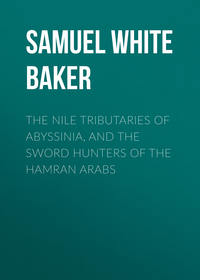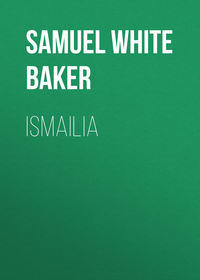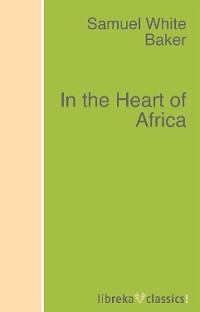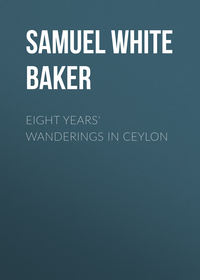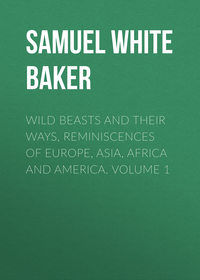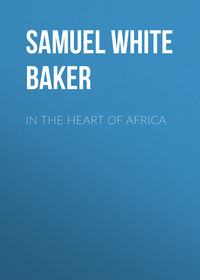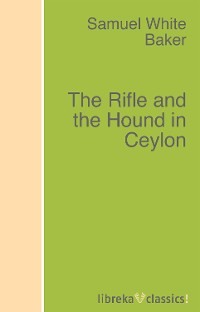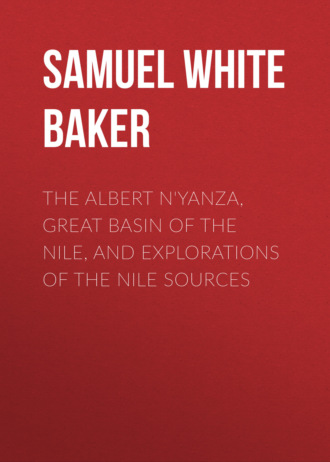 полная версия
полная версияThe Albert N'Yanza, Great Basin of the Nile, And Explorations of the Nile Sources
Should the slave-trade be suppressed, a field would be opened, the extent of which I will not attempt to suggest, as the future would depend upon the good government of countries now devoted to savage anarchy and confusion.
Any Government that would insure security would be the greatest blessing, as the perpetual hostilities among the various tribes prevent an extension of cultivation. The sower knows not who will reap, thus he limits his crop to his bare necessities.
The ethnology of Central Africa is completely beyond my depth. The natives not only are ignorant of writing, but they are without traditions—their thoughts are as entirely engrossed by their daily wants as those of animals; thus there is no clue to the distant past; history has no existence. This is much to be deplored, as peculiarities are specific in the type of several tribes both in physical appearance and in language. The Dinka; Bari; Latooka; Madi; and Unyoro or Kitwara, are distinct languages on the east of the Nile, comprising an extent of country from about 12 degrees north to the Equator.
The Makkarika have also a distinct language, and I was informed in Kamrasi's country, that the Malegga, on the west of the Albert lake, speak a different tongue to that of Kitwara (or Unyoro)—this may possibly be the same as the Makkarika, of which I have had no experience by comparison. Accepting the fact of five distinct languages from the Equator to 12 degrees N. lat., it would appear by analogy that Central Africa is divided into numerous countries and tribes, distinct from each other in language and physical conformation, whose origin is perfectly obscure. Whether the man of Central Africa be pre-Adamite is impossible to determine; but the idea is suggested by the following data. The historical origin of man, or Adam, commences with a knowledge of God.
Throughout the history of the world from the creation of Adam, God is connected with mankind in every creed, whether worshipped as the universal sublime Spirit of omnipotence, or shaped by the forms of idolatry into representations of a deity. From the creation of Adam, mankind has acknowledged its inferiority, and must bow down and worship either the true God or a graven image; or something that is in heaven or in earth. The world, as we accept that term, was always actuated by a natural religious instinct. Cut off from that world, lost in the mysterious distance that shrouded the origin of the Egyptian Nile, were races unknown, that had never reckoned in the great sum of history—races that we have brought to light, whose existence had been hidden from mankind, and that now appear before us like the fossil bones of antediluvian animals. Are they vestiges of what existed in a pre-Adamite creation?
The geological formation of Central Africa is primitive; showing an altitude above the sea-level averaging nearly 4,000 feet. This elevated portion of the globe, built up in great part of granitic sandstone rocks, has never been submerged, nor does it appear to have undergone any changes, either volcanic or by the action of water. Time, working through countless ages with the slow but certain instrument of atmospheric influence, has rounded the surface and split into fragments the granite rocks, leaving a sandy base of disintegrated portions, while in other cases the mountains show as hard and undecayed a surface as though fresh from Nature's foundry. Central Africa never having been submerged, the animals and races must be as old, and may be older, than any upon the earth.
No geological change having occurred in ages long anterior to man, as shown by Sir R. I. Murchison theoretically so far back as the year 1852, when Central Africa was utterly unknown, it is natural to suppose that the races that exist upon that surface should be unaltered from their origin. That origin may date from a period so distant, that it preceded the Adamite creation. Historic man believes in a Divinity; the tribes of Central Africa know no God. Are they of our Adamite race? The equatorial portion of Africa at the Nile sources has an average altitude above the sea-level of about 4,000 feet; this elevated plateau forms the base of a range of mountains, that I imagine extends, like the vertebrae of an animal, from east to west, shedding a drainage to the north and south. Should this hypothesis be correct, the southern watershed would fill the Tanganika lake: while farther to the west another lake, supplied by the southern drainage, may form the head of the river Congo. On the north a similar system may drain into the Niger and Lake Tchad: thus the Victoria and the Albert lakes, being the two great reservoirs or sources of the Nile, may be the first of a system of African equatorial lakes fed by the northern and southern drainage of the mountain range, and supplying all the principal rivers of Africa from the great equatorial rainfall. The fact of the centre of Africa at the Nile sources being about 4,000 feet above the ocean, independently of high mountains rising from that level, suggests that the drainage of the Equator from the central and elevated portion must find its way to the lower level and reach the sea. Wherever high mountain ranges exist, there must also be depressions; those situated in an equatorial rainfall must receive the drainage from the high lands and become lakes, the overflow of which must form the sources of rivers, precisely as exemplified in the sources of the Nile from the Victoria and the Albert lakes.
The fact that Sir Roderick Murchison, as a geologist, laid down a theory of the existence of a chain of lakes upon an elevated plateau in Central Africa, which theory has been now in great measure confirmed by actual inspection, induces me to quote an extract from his address at the anniversary meeting of the Royal Geographical Society, 23d May, 1864. In that address, he expressed opinions upon the geological structure and the races of Central Africa, which preceded those that I formed when at the Albert lake. It is with intense interest that I have read the following extract since my return to England:—
"In former addresses, I suggested that the interior mass and central portions of Africa constituting a great plateau occupied by lakes and marshes from which the waters escaped by cracks or depressions in the subtending older rocks, had been in that condition during an enormously long period. I have recently been enabled, through the apposite discovery of Dr. Kirk, the companion of Livingstone, not only to fortify my conjecture of 1852, but greatly to extend the inferences concerning the long period of time during which the central parts of Africa have remained in their present condition, save their degradation by ordinary atmospheric agencies. My view, as given to this Society in 1852, was mainly founded on the original and admirable geological researches of Mr. Bain in the colony of the Cape of Good Hope. It was, that, inasmuch as in the secondary or mesozoic age of geologists, the northern interior of that country was occupied by great lakes and marshes, as proved by the fossil reptile discovered by Bain, and named Dicynodon by Owen, such it has remained for countless ages, even up to the present day. The succeeding journeys into the interior, of Livingstone, Thornton and Kirk, Burton and Speke, and Speke and Grant, have all tended to strengthen me in the belief that Southern Africa has not undergone any of those great submarine depressions which have so largely affected Europe, Asia, and America, during the secondary, tertiary, and quasi modern periods.
"The discovery of Dr. Kirk has confirmed my conclusion. On the banks of an affluent of the Zambesi, that gentleman collected certain bones, apparently carried down in watery drifts from inland positions, which remains have been so fossilized as to have all the appearance of antiquity which fossils of a tertiary or older age usually present. One of these is a portion of the vertebral column and sacrum of a buffalo, undistinguishable from that of the Cape buffalo; another is a fragment of a crocodile, and another of a water-tortoise, both undistinguishable from the forms of those animals now living. Together with these, Dr. Kirk found numerous bones of antelopes and other animals, which, though in a fossil condition, all belonged, as he assured me, to species now living in South Africa.
"On the other hand, none of our explorers, including Mr. Bain, who has diligently worked as a geologist, have detected in the interior any limestones containing marine fossil remains, which would have proved that South Africa had, like other regions, been depressed into oceanic conditions, and re-elevated. On the contrary, in addition to old granitic and other igneous rocks, all explorers find only either innumerable undulations of sandstones, schistose, and quartzose rocks, or such tufaceous and ferruginous deposits as would naturally occur in countries long occupied by lakes and exuberant jungles, separated from each other by sandy hills, scarcely any other calcareous rocks being found except tufas formed by the deposition of landsprings. It is true that there are marine tertiary formations on the coasts (around the Cape Colony, near the mouth of the Zambesi opposite Mozambique, and again on the coasts of Mombas opposite Zanzibar), and that these have been raised up into low-coast ranges, followed by rocks of igneous origin. But in penetrating into the true interior, the traveller takes a final leave of all such formations; and in advancing to the heart of the continent, he traverses a vast region which, to all appearance, has ever been under terrestrial and lacustrine conditions only. Judging, indeed, from all the evidences as yet collected, the interior of South Africa has remained in that condition since the period of the secondary rocks of geologists! Yet, whilst none of our countrymen found any evidences of old marine remains, Captain Speke brought from one of the ridges which lay between the coast and the lake Victoria N'yanza a fossil shell, which, though larger in size, is undistinguishable from the Achatina perdix now flourishing in South Africa. Again, whilst Bain found fossil plants in his reptiliferous strata north of the Cape, and Livingstone and Thornton discovered coal in sandstone, with fossil plants, like those of our old coal of Europe and America,—yet both these mesozoic and palaeozoic remains are terrestrial, and are not associated with marine limestones, indicative of those oscillations of the land which are so common in other countries.
"It is further to be observed, that the surface of this vast interior is entirely exempt from the coarse superficial drift that encumbers so many countries, as derived from lofty mountain-chains from which either glaciers or great torrential streams have descended. In this respect, it is also equally unlike those plains of Germany, Poland, and Northern Russia, which were sea-bottoms when floating icebergs melted and dropped the loads of stone which they were transporting from Scandinavia and Lapland.
"In truth, therefore, the inner portion of Southern Africa is, in this respect, as far as I know, geologically unique in the long conservation of ancient terrestrial conditions. This inference is further supported by the concomitant absence, throughout the larger portion of all this vast area, i.e. south of the Equator, of any of those volcanic rocks which are so often associated with oscillations of the terra firma ["Although Kilimandjaro is to a great extent igneous and volcanic, there is nothing to prove it has been in activity during the historic era."]
"With the exception of the true volcanic hills of the Cameroons recently described by Burton, on the west coast, a little to the north of the Equator, and which possibly may advance southwards towards the Gaboon country, nothing is known of the presence of any similar foci of sub-aerial eruption all round the coasts of Africa south of the Equator. If the elements for the production of them had existed, the coast-line is precisely that on which we should expect to find such volcanic vents, if we judge by the analogy of all volcanic regions where the habitual igneous eruptions are not distant from the sea, or from great internal masses of water. The absence, then, both on the coasts and in the interior, of any eruptive rocks which can have been thrown up under the atmosphere since the period when the tertiary rocks began to be accumulated, is in concurrence with all the physical data as yet got together. These demonstrate that, although the geologist finds here none of those characters of lithological structure and curiously diversified organic remains which enable him to fix the epochs of succession in the crust of the earth in other quarters of the globe, the interior of South Africa is unquestionably a grand type of a region which has preserved its ancient terrestrial conditions during a very long period, unaffected by any changes except those which are dependent on atmospheric and meteoric influences.
"If, then, the lower animals and plants of this vast country have gone on unchanged for a very long period, may we infer that its human inhabitants are of like antiquity? If so, the Negro may claim as old a lineage as the Caucasian or Mongolian races. In the absence of any decisive fact, I forbear, at present, to speculate on this point; but as, amid the fossil specimens procured by Livingstone and Kirk, there are fragments of pottery made by human hands, we must wait until some zealous explorer of Southern Africa shall distinctly bring forward proofs that the manufactured articles are of the same age as the fossil bones. In other words, we still require from Africa the same proofs of the existence of links which bind together the sciences of Geology and Archaeology which have recently been developed in Europe. Now, if the unquestioned works of man should be found to be coeval with the remains of fossilized existing animals in Southern Africa, the travelled geographer, who has convinced himself of the ancient condition of its surface, must admit, however unwillingly, that although the black man is of such very remote antiquity, he has been very stationary in civilization and in attaining the arts of life, if he be compared with the Caucasian, the Mongolian, the Red Indian of America, or even with the aborigines of Polynesia." ("The most remarkable proof of the inferiority of the Negro, when compared with the Asiatic, is, that whilst the latter has domesticated the elephant for ages, and rendered it highly useful to man, the Negro has only slaughtered the animal to obtain food or ivory.")
CHAPTER XIX
THE BLACK ANTELOPE
We continued our voyage down the Nile, at times scudding along with a fair wind and stream, when a straight portion of the river allowed our men respite from the oars. This was the termination of the dry season, in this latitude 7 degrees (end of March);—thus, although the river was nearly level with the banks, the marshes were tolerably firm, and in the dryer portions the reeds had been burnt off by the natives. In one of these cleared places we descried a vast herd of antelopes, numbering several thousands. The males were black, and carried fine horns, while the females were reddish-brown and without horns. Never having shot this species, I landed from the boat, which I ordered to wait in a sheltered nook, while, accompanied by the boy Saat and Richarn, I took the little Fletcher 24 rifle and commenced a stalk.
The antelopes did not evince their usual shyness, and with a tolerable amount of patience I succeeded in getting within about 120 paces of two splendid black bucks that were separated from the herd;—a patch of half-burnt reeds afforded a good covering point. The left-hand buck was in a good position for a shoulder shot, standing with his flank exposed, but with his head turned towards me. At the crack of the rifle he sprang upon his hind legs,—gave two or three convulsive bounds, and fell. His companion went off at full speed, and the left-hand barrel unfortunately broke his hind leg, as the half-burnt reeds hindered a correct aim. Reloading, while my men bled the dead buck, I fired a long shot at the dense mass of antelopes who were now in full retreat at about 600 yards' distance crowded together in thousands. I heard, or fancied I heard, the ball strike some object, and as the herd passed on, a reddish object remained behind that we could hardly distinguish, but on nearer approach I found a doe lying dead—she had been by chance struck by the ball through the neck at this great distance. The game being at full speed in retreat, my sport would have been over had we not at that moment heard shouts and yells exactly ahead of the vast herd of antelopes. At once they halted, and we perceived a number of natives, armed with spears and bows, who had intercepted the herd in their retreat, and who now turned them by their shouts exactly towards us. The herd came on at full speed; but seeing us, they slightly altered their line, and rushed along, thundering over the ground almost in single file, thus occupying a continuous line of about half a mile in length. Running towards them at right angles for about a quarter of a mile, I at length arrived at a white ant-hill about ten feet high; behind this I took my stand within about seventy yards of the string of antelopes that were filing by at full gallop. I waited for a buck with fine horns. Several passed, but I observed better heads in their rear;—they came bounding along. "Crack!" went the rifle; and a fine buck pitched upon his head. Again the little Fletcher spoke, and down went another within ten yards of the first. "A spare gun, Richarn!" and Oswell's Purdey was slipped into my hand. "Only one barrel is loaded," said Richarn. I saw a splendid buck coming along with a doe by his side;—she protected him from the shot as they came on at right angles with the gun; but knowing that the ball would go through her and reach him on the other side, I fired at her shoulder,—she fell dead to the shot, but he went off scatheless. I now found that Richarn had loaded the gun with twenty mould shot instead of ball;—these were confined in a cartridge, and had killed her on the spot.
I had thus bagged five antelopes; and, cutting off the heads of the bucks, we left the bodies for the natives, who were anxiously watching us from a distance, but afraid to approach. The antelope first shot that was nearer to the boat, we dragged on board, with the assistance of ten or twelve men. The buck was rather larger than an average donkey;—colour, black, with a white patch across the withers;—a white crown to the head; white round the eyes; chest black, but belly white; the horns about two feet four inches long, and bending gracefully backwards.
A few days after this incident we arrived at the junction of the Bahr el Gazal, and turning sharp to the east, we looked forward to arriving at the extraordinary obstruction that since our passage in 1863 had dammed the White Nile.
There was considerable danger in the descent of the river upon nearing this peculiar dam, as the stream plunged below it by a subterranean channel with a rush like a cataract. A large diahbiah laden with ivory had been carried beneath the dam on her descent from Gondokoro in the previous year, and had never been seen afterwards. I ordered the reis to have the anchor in readiness, and two powerful hawsers; should we arrive in the evening, he was to secure the vessel to the bank, and not to attempt the passage through the canal until the following morning. We anchored about half a mile above the dam.
This part of the Nile is boundless marsh, portions of which were at this season terra firma. The river ran from west to east; the south bank was actual ground covered with mimosas, but to the north and west the flat marsh covered with high weeds was interminable.
At daybreak we manned the oars and floated down the rapid stream. In a few minutes we heard the rush of water, and we saw the dam stretching across the river before us. The marsh being firm, our men immediately jumped out on the left bank and manned the hawsers—one fastened from the stern, the other from the bow; this arrangement prevented the boat from turning broadside on to the dam, by which accident the shipwrecked diahbiah had been lost. As we approached the dam, I perceived the canal or ditch that had been cut by the crews of the vessels that had ascended the river; it was about ten feet wide, and would barely allow the passage of our diahbiah. This canal was already choked with masses of floating vegetation and natural rafts of reeds and mud that the river carried with it, the accumulation of which had originally formed the dam.
Having secured the vessel by carrying out an anchor astern and burying it on the marsh, while a rope fastened from the bow to the high reeds kept her stern to the stream, all hands jumped into the canal and commenced dragging out the entangled masses of weeds, reeds, ambatch wood, grass, and mud that had choked the entrance. Half a day was thus passed, at the expiration of which time we towed our vessel safely into the ditch, where she lay out of danger. It was necessary to discharge all cargo from the boat, in order to reduce her draught of water. This tedious operation completed, and many bushels of corn being piled upon mats spread upon the reeds beaten flat, we endeavoured to push her along the canal. Although the obstruction was annoying it was a most interesting object.
The river had suddenly disappeared: there was apparently an end to the White Nile. The dam was about three-quarters of a mile wide; it was perfectly firm, and was already overgrown with high reeds and grass, thus forming a continuation of the surrounding country. Many of the traders' people had died of the plague at this spot during the delay of some weeks in cutting the canal; the graves of these dead were upon the dam. The bottom of the canal that had been cut through the dam was perfectly firm, composed of sand, mud, and interwoven decaying vegetation. The river arrived with great force at the abrupt edge of the obstruction, bringing with it all kinds of trash and large floating islands. None of these objects hitched against the edge, but the instant they struck they dived under and disappeared. It was in this manner that the vessel had been lost—having missed the narrow entrance to the canal, she had struck the dam stem on; the force of the current immediately turned her broadside against the obstruction; the floating islands and masses of vegetation brought down by the river were heaped against her, and heeling over on her side she was sucked bodily under and carried beneath the dam; her crew had time to save themselves by leaping upon the firm barrier that had wrecked their ship. The boatmen told me that dead hippopotami had been found on the other side, that had been carried under the dam and drowned.
Two days' hard work from morning till night brought us through the canal, and we once more found ourselves on the open Nile on the other side of the dam. The river was in that spot perfectly clean; not a vestige of floating vegetation could be seen upon its waters; in its subterranean passage it had passed through a natural sieve, leaving all foreign matter behind to add to the bulk of the already stupendous work.
All before us was clear and plain sailing. For some days two or three of our men had been complaining of severe headache, giddiness, and violent pains in the spine and between the shoulders. I had been anxious when at Gondokoro concerning the vessel, as many persons had died on board of the plague during the voyage from Khartoum. The men assured me that the most fatal symptom was violent bleeding from the nose; in such cases no one had been known to recover. One of the boatmen, who had been ailing for some days, suddenly went to the side of the vessel and hung his head over the river; his nose was bleeding!
Another of my men, Yaseen, was ill; his uncle, my vakeel, came to me with a report that "his nose was bleeding violently!" Several other men fell ill: they lay helplessly about the deck in low muttering delirium, their eyes as yellow as orange-peel. In two or three days the vessel was so horribly offensive as to be unbearable; THE PLAGUE HAD BROKEN OUT! We floated past the river Sobat junction; the wind was fair from the south, thus fortunately we in the stern were to windward of the crew. Yaseen died; he was one who had bled at the nose. We stopped to bury him. The funeral hastily arranged, we again set sail. Mahommed died; he had bled at the nose. Another burial. Once more we set sail and hurried down the Nile. Several men were ill, but the dreaded symptom had not appeared. I had given each man a strong dose of calomel at the commencement of the disease; I could do nothing more, as my medicines were exhausted. All night we could hear the sick, muttering and raving in delirium, but from years of association with disagreeables we had no fear of the infection. One morning the boy Saat came to me with his head bound up, and complained of severe pain in the back and limbs, with all the usual symptoms of plague: in the afternoon I saw him leaning over the ship's side; his nose was bleeding violently! At night he was delirious. On the following morning he was raving, and on the vessel stopping to collect firewood he threw himself into the river to cool the burning fever that consumed him. His eyes were suffused with blood, which, blended with a yellow as deep as the yolk of egg, gave a horrible appearance to his face, that was already so drawn and changed as to be hardly recognised. Poor Saat! the faithful boy that we had adopted, and who had formed so bright an exception to the dark character of his race, was now a victim to this horrible disease. He was a fine strong lad of nearly fifteen, and he now lay helplessly on his mat, and cast wistful glances at the face of his mistress as she gave him a cup of cold water mixed with a few lumps of sugar that we had obtained from the traders at Gondokoro.


